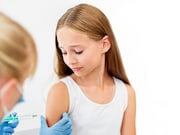One dose compared with two or three doses in preventing cervical precancer in high-coverage settings
THURSDAY, Aug. 1, 2019 (HealthDay News) — One dose of prophylactic human papillomavirus (HPV) vaccine may be as effective as two or three doses in preventing high-grade disease in a high-coverage setting, according to a study published online July 15 in Papillomavirus Research.
Julia M.L. Brotherton, Ph.D., from the National HPV Vaccination Program Register in Melbourne, Australia, and colleagues used linked registry data from all eight jurisdictional cervical screening registers, the national HPV vaccination register, death index, and cancer registers for all Australian women (aged ≤15 years when eligible for vaccine; April 2007 through December 2014).
The researchers found that of the 250,648 included women, 19.5 percent were unvaccinated, 69.8 percent received three doses, 7.3 percent received two doses, and 3.4 percent had one dose. The adjusted hazard ratios for one-dose and two-dose recipients were comparable to those of three-dose recipients (one dose: 1.01; 95 percent confidence interval, 0.81 to 1.26; two doses: 1.00; 95 percent confidence interval, 0.85 to 1.17) after adjusting for age at vaccination among the vaccinated group. Based on comparison with a historical cohort of age-matched women, the result was not due to herd protection alone.
“These findings support the hypothesis that one dose vaccination may be a viable strategy when working towards the global elimination of cervical cancer,” the authors write.
Copyright © 2019 HealthDay. All rights reserved.








